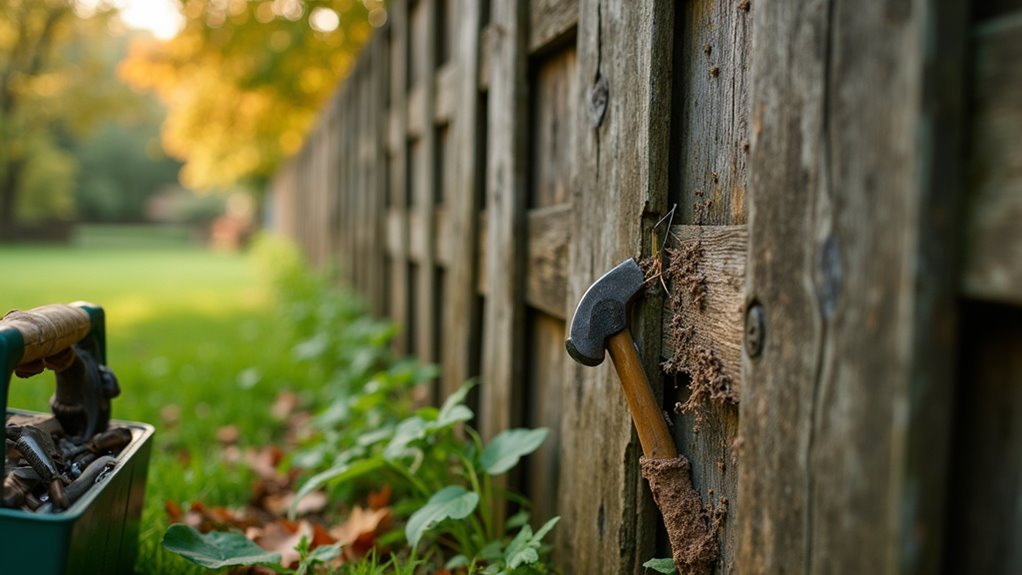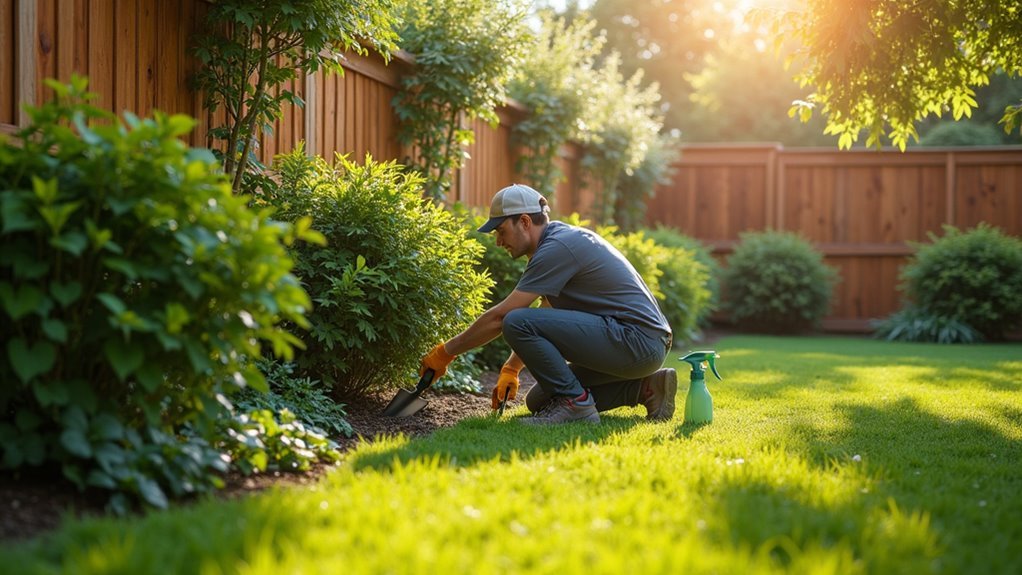Maintain your outdoor pest barriers by regularly inspecting and repairing screens, weatherstripping, and foundation cracks before peak pest seasons. Clear vegetation and debris within two feet of your foundation, and keep firewood at least 30 feet away. Guarantee proper drainage by cleaning gutters and directing water away from structures. Apply natural repellents like essential oil sprays every 2-3 weeks during warm months. Professional assessments twice yearly will help you identify vulnerabilities and discover advanced strategies for year-round protection.
Inspect and Repair Physical Barriers Before Peak Pest Seasons

Before pest activity peaks during warmer months, you’ll need to thoroughly examine and fortify your home’s physical defenses.
Start by checking screens on windows and doors for holes or tears that enable pest entry. Even small openings allow mosquitoes and flies inside.
Next, inspect weatherstripping around doors and windows, ensuring airtight seals. Examine your foundation for cracks and gaps, then seal these openings to prevent rodents from entering.
Verify that door sweeps fit tightly at exterior door bottoms to block access.
Don’t overlook outdoor structures like porches and patios—inspect these areas for gaps and seal them immediately.
These physical barriers form your first line of defense in extensive pest prevention strategies.
Clear Vegetation and Debris Around Perimeter Defenses
While physical barriers provide essential protection, the area surrounding your home’s perimeter requires equal attention to maintain effective pest control.
You’ll need to clear vegetation and debris within two feet of your foundation, removing thick mulch and leaf litter that creates pest harborage sites. Overgrown shrubs should be trimmed to prevent them from touching your home’s exterior, eliminating pathways for pests.
Keep firewood, brush piles, and compost bins at least 30 feet away, as these materials are attractive to pests. Maintain a tidy landscape by promptly disposing of fallen fruit and organic debris.
These practices strengthen your perimeter defenses and reduce the need for professional pest control services.
Maintain Proper Drainage to Eliminate Moisture Buildup

Since moisture attracts numerous pests and creates ideal breeding conditions, you’ll need to establish and maintain proper drainage systems around your property.
Effective drainage systems are your first line of defense against moisture-loving pests that threaten your home’s comfort and safety.
Standing water becomes a magnet for mosquitoes, termites, and other unwanted visitors that can compromise your outdoor living spaces.
Focus on these essential drainage maintenance tasks:
- Clean gutters regularly and direct downspouts away from your foundation to prevent water pooling near potential entry points
- Inspect and repair foundation cracks or exterior wall holes that allow moisture buildup inside your home’s perimeter
- Use proper landscaping techniques, including soil grading away from structures and maintaining French drains
These proactive measures will reduce the likelihood of creating environments where pests thrive, helping you prevent pests from establishing colonies and minimize ongoing pest problems around your property.
Apply Seasonal Natural Repellent Treatments
Natural repellent treatments offer an eco-friendly approach to pest control that protects your outdoor spaces without introducing harsh chemicals into your environment.
When you apply seasonal treatments regularly, you’ll reduce mosquito activity by up to 50% compared to chemical pesticides.
Create a homemade spray using essential oils like lavender and eucalyptus mixed with water for effective insect deterrent properties. Garlic spray releases sulfur compounds that naturally prevent pests from establishing territories in your garden.
You should reapply these natural repellents every 2-3 weeks during warm months for continuous protection.
Additionally, plant marigolds and basil around your property—their pest-repelling properties create natural barriers while enhancing your landscape’s visual appeal and maintaining long-term outdoor pest control.
Schedule Regular Professional Barrier Assessments

Professional barrier assessments serve as your property’s annual health checkup, guaranteeing every line of defense against pests remains strong and effective.
Schedule these professional pest control service evaluations at least twice yearly to maintain pest-proofing measures that prevent pests from entering your home.
During assessments, experts identify entry points to prevent future infestations by sealing newly developed cracks or gaps.
These detailed evaluations guarantee your pest-proofing barriers adapt to changing seasons and local pest control trends.
Key benefits include:
- Early Detection: Spot early signs of pest activity before infestations develop
- Proactive Sealing: Address structural vulnerabilities that create new access routes
- Seasonal Adaptation: Receive tailored recommendations for current pest threats
Consistent professional evaluations enable timely interventions, keeping your outdoor barriers functioning effectively year-round while preventing costly pest problems.
Frequently Asked Questions
How Long Do Outdoor Pest Barriers Typically Last Before Needing Replacement?
You’ll typically replace outdoor pest barriers every 6-12 months, depending on weather conditions and barrier type. Chemical treatments last shorter periods, while physical barriers like copper tape or diatomaceous earth need renewal more frequently.
What Materials Are Most Cost-Effective for DIY Pest Barrier Construction?
You’ll find hardware cloth and copper mesh offer excellent value for blocking rodents and insects. Diatomaceous earth works cost-effectively against crawling pests, while essential oil-soaked cotton balls deter various insects affordably.
Can Pest Barriers Harm Beneficial Insects Like Bees and Butterflies?
You’ll find that physical barriers like row covers and copper strips won’t harm beneficial insects. However, chemical barriers and sticky traps can kill bees and butterflies, so you should choose selective methods carefully.
Do Weather Conditions Affect Which Types of Barriers Work Best?
You’ll find that rain weakens sticky traps and washes away spray barriers. Wind reduces netting effectiveness, while heat damages plastic materials. Cold weather makes some chemical barriers less active, so you’ll need weather-appropriate solutions.
Are There Legal Restrictions on Barrier Heights in Residential Areas?
You’ll need to check local zoning ordinances and HOA regulations before installing tall barriers. Most residential areas limit fence heights to 6-8 feet, but specific restrictions vary by municipality and property location.
In Summary
You’ll keep your property pest-free by staying proactive with these maintenance strategies. Don’t wait until you’re dealing with an infestation to address barrier weaknesses. Regular inspections, vegetation management, and drainage control create multiple defense layers that pests can’t easily penetrate. When you combine DIY maintenance with professional assessments, you’re investing in long-term protection that’ll save you time, money, and frustration throughout every pest season.





Leave a Reply